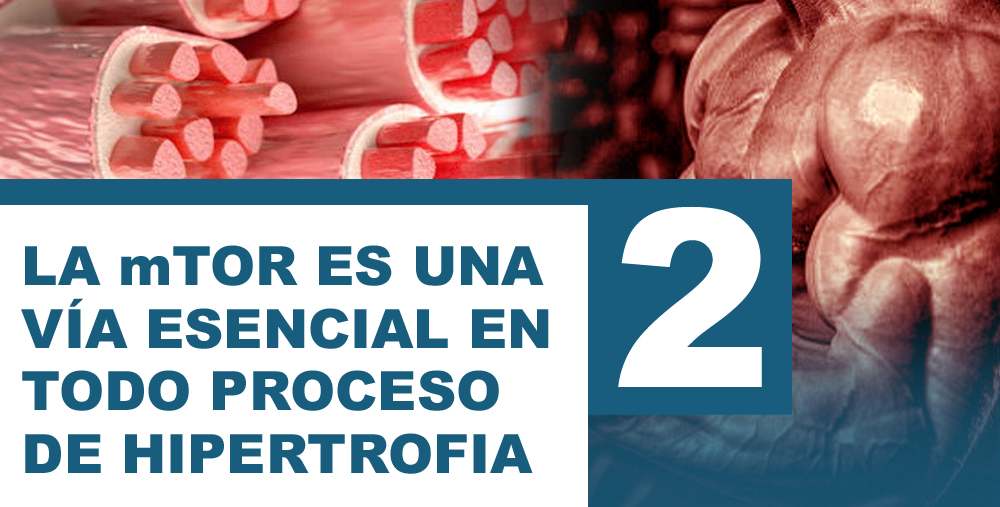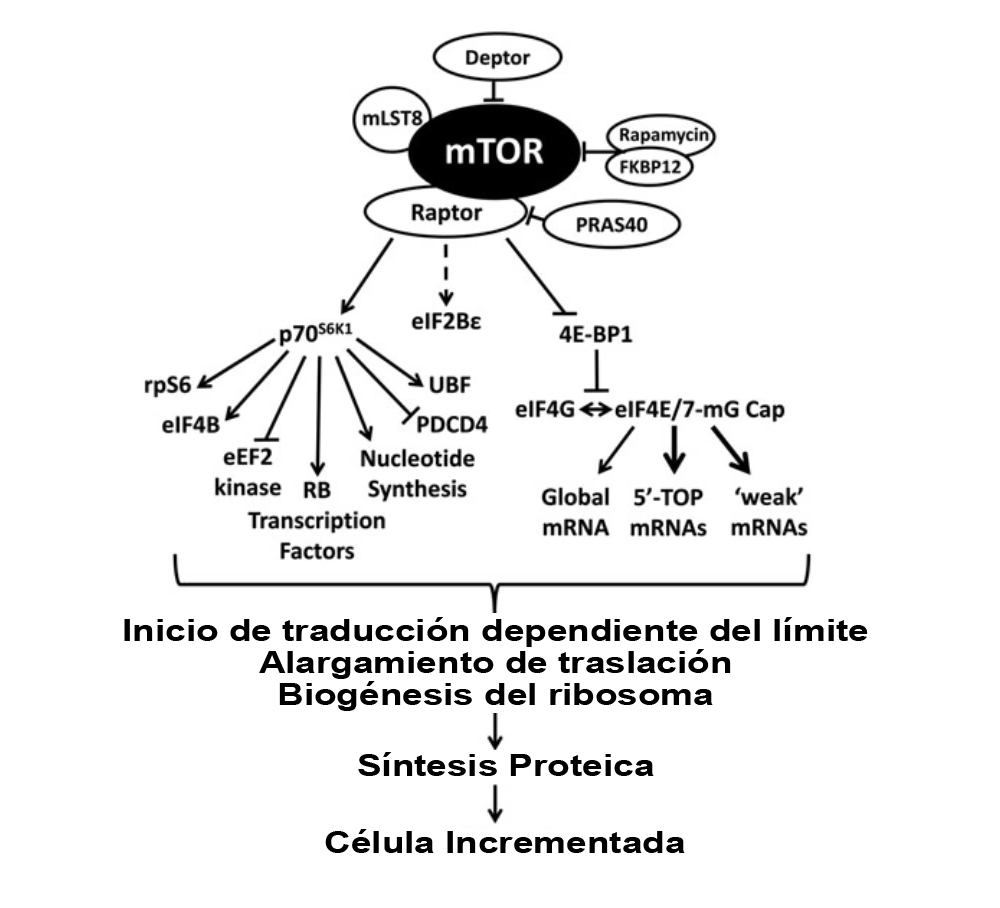When discussing a controversial topic such as mTOR and hypertrophy, we analyze the theory and conclude with the presentation by Roberto Castellano.
Before talking about the mTOR pathway, let us remember that to achieve hypertrophy, everything translates into activating satellite cells. To do this we have three mechanisms: training, diet and hormones (the endocrine system).
Roberto Castellano tells us that when a training occurs damage occurs, which triggers an immune response.
This is a critical point that is not always seen, because if the immune system is not well it simply does not grow, in addition to the body being much easier exposed to diseases.
Training produces: an immune response, which leads to inflammation, which induces an influx of blood to damaged tissue.
This blood transport serves to eliminate waste, because when the muscles are damaged, they need macrophages to go to it, to eat the waste of damaged cells, remove lactic acid, etc.
Only when this inflammatory process is over can hypertrophy occur; That is why precisely when you train a muscle group in a row, it does not work, since the entire recovery process does not occur for hypertrophy to occur.

The mTOR : what is it?
It is a protein kinase, responsible for cellular metabolism at the hypertrophy level, but it is also responsible for tumors.
For this reason, what is fashionable is not always completely the best; In the case of medicine, mTOR is studied precisely because it can cause certain pathologies such as cancer for example.
Now, according to a study published in the journal Frontiers – Physiology in 2017, the maintenance of skeletal muscle mass is regulated by the balance between anabolic and catabolic processes (1)
- The purpose of rapamycin in mammals ( mTOR ) is to perform vital functions in protein synthesis.
- Recent findings have continued to refine our understanding of the role of mTOR in maintaining skeletal muscle mass.
In a sense, this protein controls anabolic and catabolic signaling of skeletal muscle mass, resulting in the modulation of muscle hypertrophy and muscle wasting.
The mTOR and satellite cells
During myogenesis, satellite stem cells are induced to proliferate and differentiate into myogenic precursors. Myogenesis is the process that builds muscle tissue cells and this is crucial for hypertrophy.
mTOR is a key regulator of protein synthesis, cell proliferation and energy metabolism, however for our compression purposes it is necessary to determine its function in muscle stem cells (satellite cells) and the regeneration of skeletal muscle.
In a study from 2015, a laboratory work was carried out where it was observed that the regeneration of skeletal muscle after an injury (such as that produced in training) was seriously compromised in the absence of mTOR (2).
- The scientific method was that a greater number of necrotic myofibers appeared infiltrated by an Evans blue dye, in addition to a reduced number and size of myofibers generated in these rodents.
- To dissect the cellular mechanism, satellite cell-derived primary myoblasts that grew on individual myofibers or adhered to culture dishes were analyzed.
In this method, myoblasts from modified rodents exhibited defective proliferation and differentiation kinetics compared to myoblasts derived from littermates.

These results suggest that mTOR is essential for the function of satellite cells and the regeneration of skeletal muscle by controlling the expression of myogenic genes.
La mTOR : amino acids and carbohydrates
Protein turnover in the muscle cell is a complex process that encompasses both protein synthesis and protein breakdown.
Increasing muscle mass requires a greater amount of muscle protein synthesis along with a reduction in the breakdown of muscle proteins, and this at a nutritional level requires the correct consumption of macronutrients.
More specifically, certain macronutrients achieve increased muscle protein synthesis by activating mTOR , which drives muscle growth.
Recently, several scientific studies drew attention to the activation of mTOR by essential amino acids, especially leucine.
- In the first study, Walker et al.2 demonstrated that the intake of essential amino acids, specifically leucine, increased the activity of mTOR .
- Interestingly, this study also confirmed that consuming higher amounts of essential amino acids increased the cellular reserve of amino acids.
- More essential amino acids within the muscle cell stimulate the insulin signaling pathway, thus activating mTOR .
But, other studies such as those done by Wilson et al. show that carbohydrates need to be added and that as the preferred energy source for muscle cells, the anabolic environment will be enhanced.
Interestingly, the preferential use of carbohydrates by the muscle cell generates cellular energy (ATP).
- In this scenario, AMPK, the cell’s energy sensing meter, will shut down due to ATP production.
- Since AMPK activates by inhibiting mTOR, turning off AMPK will also stimulate mTOR activity.
The mTOR : what about fats?
Long-chain omega-3 fatty acids stimulate muscle protein synthesis by activating mTOR .
The latest research by Gingras et al.5 presents long-chain omega-3 fatty acids as specific activators of this protein kinase and muscle protein synthesis through the insulin signaling pathway.
Thus, it was established that long-chain omega-3 fatty acids improve the signaling pathway of the protein synthesis-mTOR-insulin relationship.
It does this by decreasing inflammation throughout the body, which has been shown to cause insulin insensitivity.
In addition, they showed that the consumption of long chain omega-3s produced an increase in the incorporation of amino acids in the synthesis of muscle proteins by 108%, provided that they are consumed a few hours after training, but not at the end of a workout. training session.
Just as certain macronutrients stimulate mTOR activity and muscle protein synthesis, other macronutrients inhibit muscle signaling and protein synthesis.

A study by Rivas et al.7 confirmed that consuming a diet high in fat triggers insensitivity to insulin, which produces a decrease in the signaling of this pathway and in the synthesis of muscle proteins.
Inhibition of mTOR comes from negative feedback within the insulin signaling pathway. Chronic consumption of a high-fat diet over-activates it, which in turn strongly activates the S6K molecule.
An overactive S6K molecule produces inactivating signals within the insulin signaling cascade, which decreases insulin sensitivity along with mTOR activation and protein synthesis.
The mTOR : restricted diet
mTOR integrates various internal and external signals to regulate many cellular activities, including mRNA translation, protein synthesis, cell growth and proliferation, autophagy, lipogenesis, and thermogenesis
In this sense, it exerts its biological activities in mammalian cells, forming two different complexes:
- The mTOR1 complex (mTORC1)
- The mTOR2 complex (mTORC2).
In all scenarios, both differ in their components, regulation, function, and sensitivity to rapamycin.
Specifically, mTORC1 activity is stimulated by growth factors, hormones, and other factors.
It is also regulated by nutrients such as glucose and amino acids, consequently the diet must be taken into account.
Thus, as branched-chain amino acids (BCAAs) such as leucine and arginine are potent activators of mTORC1, energy limitation, such as glucose deprivation and hunger, strongly inhibits mTORC1 activation by stimulating AMPK for energy deprivation.
AMPK is another critical cellular energy sensor that suppresses the activity of mTORC1.
Conclusions
As we can see in this illustration, mTOR connects with protein synthesis and cell growth through different pathways.

This means that it indirectly influences hypertrophy. Something like the way a car engine is necessary for it to move, but it still needs other “ways” such as the steering wheel, the cooling mechanisms, the clutch, etc., and this should be clear.
Resistance exercise (with weights or accessories) activates mTOR and since training stimulates muscle gains, there is a link with hypertrophy.
mTOR is associated not only with protein synthesis but also with protein degradation (catabolic effect).
The Goodman study done in 2014 shows that it is inversely connected to this process, which prevents catabolism (3).
Finally, Roberto Castellano explains to us in a video how the mTOR pathway is activated and its relationship with hypertrophy.



